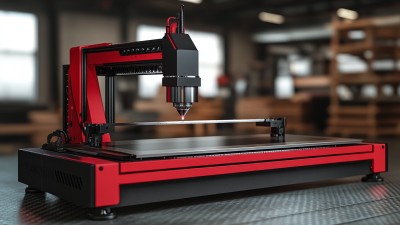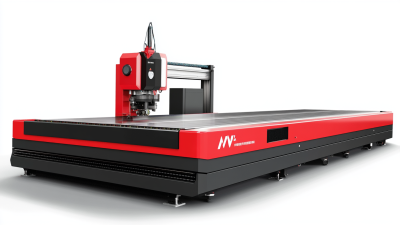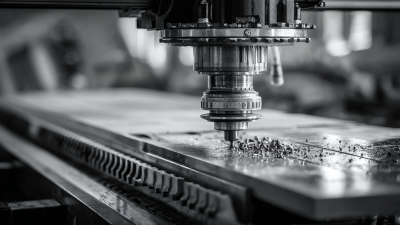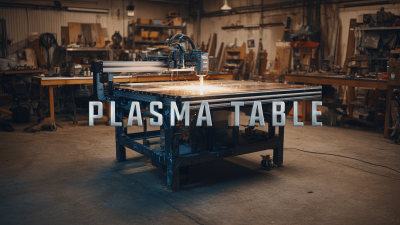Revolutionize Your Workshop with Advanced Laser Cutting Table Technology
In the rapidly evolving landscape of manufacturing, the introduction of advanced Laser Cutting Table technology is revolutionizing workshops across industries. According to a recent report by MarketsandMarkets, the global laser cutting market is expected to reach USD 5.5 billion by 2026, growing at a CAGR of 6.8%. This growth is driven by the increasing demand for precision, efficiency, and versatility in fabrication processes. Laser Cutting Tables facilitate intricate designs and high-speed performance, allowing manufacturers to achieve unmatched accuracy while minimizing material waste. As businesses strive to enhance productivity and reduce operational costs, the integration of these cutting-edge tables is no longer a luxury but a necessity for staying competitive in the modern market. The evolution of Laser Cutting Table technology presents an opportunity for workshops to optimize their capabilities and adapt to the future of fabrication.

Transforming Your Workshop with Laser Cutting Tables
Laser cutting tables are transforming workshops by enhancing precision and efficiency in crafting and design. As industries continue to embrace advanced technologies, the integration of laser cutting systems is becoming increasingly vital. According to a recent report, the global laser cutting machine market is projected to reach $5.77 billion by 2025, growing at a CAGR of 7.4%. This surge highlights the importance of laser cutting technology in various sectors, including manufacturing and architecture.
Furthermore, innovations such as virtual reality are paving the way for immersive design experiences in workshops. For instance, combining VR with laser cutting allows designers to visualize their projects in a 3D space before execution. This integration not only streamlines the design process but also enhances collaboration among teams. As more workshops adopt these advanced laser cutting tables, they are not just improving their production capabilities but also redefining how creative professionals approach their work, fostering an environment where imagination can truly take flight.
Key Features of Advanced Laser Cutting Technology
Advanced laser cutting technology is transforming workshops by offering high precision and efficiency in material processing. One of the key features is its ability to cut a variety of materials, including metals, plastics, and wood, with exceptional accuracy. This flexibility allows manufacturers and craftsmen to explore new design possibilities and create intricate patterns that were previously difficult or impossible to achieve with traditional cutting methods.
Another notable aspect is the automation capabilities of modern laser cutting tables. Equipped with advanced software, these systems can streamline the cutting process, significantly reducing production time while enhancing repeatability. Additionally, features such as real-time monitoring and adaptive control allow for immediate adjustments in cutting speeds and power levels, ensuring optimal performance across different projects. The integration of such technology not only improves workflow efficiency but also reduces material waste, making it a cost-effective solution for businesses.
Choosing the Right Laser Cutting Table for Your Needs
When selecting a laser cutting table, it’s essential to consider several key factors to ensure it meets your specific needs. First, evaluate the material types you will be cutting. Different laser cutting tables are designed to handle various materials, such as wood, acrylic, metal, or textiles. Understanding your primary applications will guide you in choosing a table equipped with the right power and cutting capabilities.
Next, factor in the table’s size and working area. Depending on the projects you undertake, a larger table may be necessary for accommodating bigger materials or multiple pieces simultaneously. Additionally, consider the machine's precision and speed, as these attributes heavily influence productivity and the quality of the final products. An advanced laser cutting table with robust software integration can further enhance your workshop’s efficiency, offering greater control and design capabilities. By carefully assessing these elements, you can select the ideal laser cutting table that aligns with your workshop's goals and elevates your cutting processes.

Maximizing Efficiency: Tips for Laser Cutting Workflow
In today's competitive manufacturing landscape, maximizing efficiency in the laser cutting workflow is crucial for staying ahead. According to a report by the International Laser Manufacturing Society, companies that implement advanced laser cutting technologies can see productivity increases of up to 30%. This advancement not only streamlines production but also significantly reduces operational costs.

Tips for enhancing your laser cutting efficiency include optimizing material setup. Ensure that the laser cutting table is configured to minimize wasted material by strategically nesting designs. This can lead to a material savings of 15-20%, as demonstrated in a recent study by the Laser Institute of America.
Additionally, investing in automated loading and unloading systems can significantly reduce downtime, enabling a smoother workflow and freeing operators for other critical tasks.
Another effective strategy is to regularly maintain and calibrate your laser cutting equipment. A well-maintained machine operates at peak performance, which can enhance cut quality and reliability. In fact, a report by the National Institute of Standards and Technology states that routine maintenance can decrease machine failure rates by up to 40%. By implementing these tips, workshops can effectively harness the power of advanced laser cutting technologies to drive productivity and profitability.
Maintenance Best Practices for Laser Cutting Equipment
When operating advanced laser cutting tables, regular maintenance is crucial for ensuring optimal performance and longevity. One of the best practices involves conducting routine inspections of the equipment. This includes checking for wear and tear on the laser lens, mirrors, and belts. Even a slight misalignment can lead to significant inaccuracies in cutting, which can impede workflow and increase material waste. Regular cleaning of these components not only helps maintain precision but also enhances the overall efficiency of the machine.
Another essential aspect of maintenance is software updates and calibration. As technology evolves, software fixes and enhancements can improve machine functionality and security. It's important to follow the manufacturer’s guidelines for calibrating the laser cutting table to avoid discrepancies during operation. Additionally, training staff on proper usage and troubleshooting techniques can further prevent downtime and costly repairs, ensuring that the workshop remains productive and capable of harnessing the full potential of advanced laser cutting technology.
Laser Cutting Equipment Maintenance Best Practices
Related Posts
-

Challenges When Choosing the Right Best Cnc Plasma Table for Your Business Needs
-

7 Reasons Why the Best CNC Cutter Can Transform Your Manufacturing Process
-

Resilient Growth of Chinese Manufacturers in the Face of US China Tariffs and the Rise of Best Small CNC Plasma Cutters
-

Overcoming Common Challenges in Sourcing the Best CNC Tables for Your Business
-

What is a Plasma Table? Unlocking the Power of Precision Cutting in Modern Manufacturing
-

How to Choose the Best Plasma Table for Your Business Needs